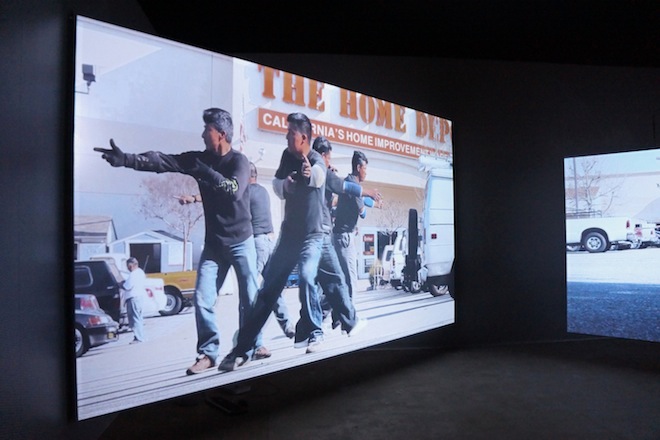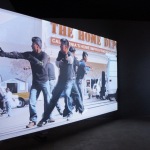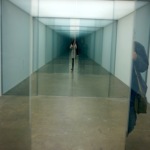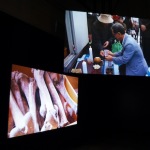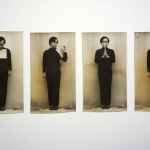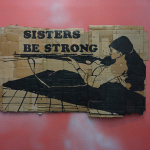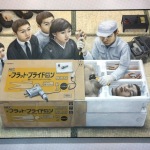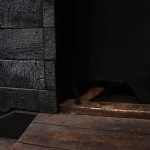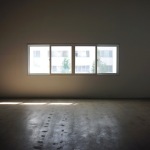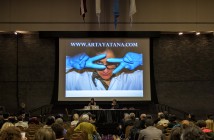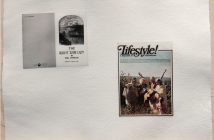"Burning Down the House," the theme of this year's biennale—a poppy5 combination of ghostly nostalgia for domesticity and ashen proof of recent conflagration—seems an apt way to address Korea's current orientation toward the wider world. The country is poised for economic boom—with old ways of doing things falling away at a breakneck pace—but is plagued by recent memories of repression despite the ever-increasing perkiness of its K-poppers.
According to the New York Times6, Artistic Director Jessica Morgan sees the "art-world status quo" as the house on fire here, and my sense is that if I had been exposed to the performances that were a part of the programming I might have agreed. Without them, both the metaphor and the exhibition seem less alive and flickering, but there were definitely some sparks of what the biennale is known for, even without the live art. There were also a lot of opportunities for reflection...
Smoke and mirrors...
Sliding Doors, a 2003 piece by Belgian artist (living in Sweden) Carsten Höller consists of seven pairs of mirrored, motion-sensitive doors that had to be passed through in order to leave the final major gallery in the main exhibit hall. Disconcerting, clinical, a little out of control (because each new person entering the passageway sets off a different pattern of openings and closings), but ultimately very satisfying. Transitions, as mentioned in the footnoted article later in this piece from Art Review, are given great attention in this biennale. Every stairway landing is dedicated to a video projection, every portal requires passage through an artwork. No movement from level to level or building to building is without engagement in some kind of process.
Leaving the bones at the door...
Navigation ID, a 2014 performance, video and installation (but these words don't actually quite cover what was done here) by South Korean artist Minouk Lim. There are two shipping containers on the Biennale Square plaza, and a two-channel video projection in one of the main galleries, meant to bring unresolved questions about an unprovoked government massacre of civilians near the beginning of the Korean War in 1950. The videos track Lim's performances and attempts by the families of the victims to retrieve remains and obtain proper burials for their relatives. The shipping containers house these remains, and were delivered by the families (with Lim) to the Biennale plaza where they were greeted by mothers of the victims of the 1980 massacre in Gwangju which is the impetus for the biennale.
Emphasis on action...
Location, by Neungkyung Sung is the record of a 1976 performance where the artist placed a copy of Space (an art and architecture magazine) on different parts of his body. It's one of many works in the show emphasizing action of various kinds—in this case with a fair amount of humor—and also seems to be the earliest piece of Korean performance art represented. Another 2d piece that falls into this category, and which was a pleasure to see in person, is Yves Klein's Untitled, (Pour Madame Everaert avec l'amitiè d'Yves Klein) from a 1961 series of "fire paintings" made by holding cardboard over a flame.
Video...
Most of my personal favorite works in the biennale were video pieces (and actually my very favorite video—The Incidental Insurgents7—was created in part by a Boston artist, Ruanne Abou-Rahme). The still here is from Octopus, a 2011 two-channel video installation by Mexican artist Yoshua Okòn, shot in a parking lot at a Home Depot in Los Angeles where he hired undocumented day laborers to reenact battles from the 36 year long Guatemalan Civil War. Many of the actors were also involved in civil wars in their real lives. Two other videos worth keeping an eye out for elsewhere include a 2014 video by Allora & Calzadilla documenting a performance by a piece of heavy industrial machinery with a bell attached to it in a dilapidated pharmaceutical plant (The Bell, the Digger and the Tropical Pharmacy), and a 1993 music video about caste oppression by Anand Patawardhan (We Are Not Your Monkeys).
Low fi, highly charged...
Capitalist Vampire, Memory of a Paris Commune, and Sisters Be Strong are all large scale works in magic marker and cardboard created between 2012 and 2013 by American artist-activist Andrea Bowers. Her work, and several other (feminist/activist) works in the exhibition have an iconic, banner-like quality to them, but are made from simple or found materials—in particular a group of paintings by the Korean artist group Dung-Ji (discussed in some detail in the Guardian8) and works by Turkish embroiderer-activist Güneş Terkol. The contrast between the content and the materials highlights the amount of effort involved in making art/making change.
Painting...
Japanese painter Tetsuya Ishida's 1998 self-portrait Recalled and several of his other paintings were among the most-photographed works in the exhibition. It was hard to get through the room where they were being presented without winding up in someone's selfie. Each of the paintings on view combine aspects of humans, machines and animals in different ways and set them in domestic or industrial settings where they seem completely lost and dysfunctional. This year's biennale featured an incredible collection of contemporary, mostly realist paintings. Other highlights were Xiaodong Liu's 2004 series of split portraits of Chinese and Taiwanese soldiers called Battlefield Realism: The Eighteen Arhats and Cornel Brudascu's 1970's solarized, neon "proletcult" depictions of bohemian Romanians.
Sculpture and Installation...
The most literal interpretations of this year's biennale's theme were to be found among the sculpture and installation collections. An actual house (The Island) was built and set on fire by Argentinian artist Eduardo Basualdo in 2009.
 Renata Lucas Until it Becomes an Inconvenient Stranger, 2014
Renata Lucas Until it Becomes an Inconvenient Stranger, 2014Photo: Heather Kapplow © 2014 (All rights reserved.)
This is probably the place to talk about an installation that you have been seeing in the background of many of these images. Curator Jessica Morgan commissioned UK collective Ultimo Grito to develop a "pixelated flame-and-smoke-motif" wallpaper that wraps the entire interior of the main exhibition building. At times it's extremely pixelated—just pattern—at other times there are hints of people or objects enveloped or disappearing into plumes of smoke and other action of various types. It's an attempt to make the building feel less like a building and more like an actual wall of smoke... Another intervention in the building (and my very favorite piece in the whole exhibition) is Brazilian artist Renata Lucas' Until it Becomes an Inconvenient Stranger. This is simply a set of windows, of exactly the style of windows used in every one of the large housing complexes all over Korea, looking out on just such another set of (already existing windows) right across the Biennale Plaza from the exhibition hall. This, more than any other piece in the show, felt to me like a true breakdown of the line between the inside and the outside of the art world—an opportunity for a breath of fresh air and for "neighbors" to peek in on one another's domestic (and/or non-domestic) lives. Other notable pieces of installation that reference the home explicitly (beyond the massive commissioned piece by Urs Fischer, 38 E. 1ST ST.) include Jianyi Geng's collection of useless items and Renate Bertlman's 1976-77 Washing Day.
....................................................................
I should mention a few technical things here: I had set aside two days to visit the biennale but underestimated the travel time involved in getting there and the length of time that the biennale would be open. Despite its being meant for locals to enjoy9, it is only open during 9-5 business hours on weekdays, so I saw everything that I saw in one day.
On that one day droves—DROVES—of small children were herded through the exhibit halls so fast that it seems impossible they could have seen a single piece of art. There were thousands of them—I counted over 50 groups of 20-30 children, in uniform and out of uniform, from preschool aged through high school. I've never seen anything like it, but I was told it happens every day so I'm certain that at least every school kid in Gwangju went to the biennale, and possibly every school kid in the country. But oddly when I asked the curator of a Gwangju contemporary art gallery, Salt10, whether he had gone, he responded that had not. I also found that none of the artists (mostly performance artists) that I spoke to in Seoul had gone, though many mentioned friends who had been involved in the live performances that occurred at the biennale. I'm not sure what this means, but felt it was worth mentioning.
It seems also worth mentioning that I was only able to find work by one African artist in this biennale.
Finally, I should note that even though I am in general an AA Bronson fan, I didn't spend any time here covering his extensive project House of Shame, which was a significant part of the biennale. It has been very comprehensively covered in an interview of Bronson by Stuart Comer11, and by Bronson's extremely charming husband Mark Jan Krayenhoff van de Leur12 in Hyperallergic. Since the Western press coverage of this biennale has been fairly sparse this year, I've tried to focus on capturing works that haven't been mentioned elsewhere.
- Yoshua Okòn Octopus, 2011 Photo: Heather Kapplow © 2014 (All rights reserved.)
- Carsten Höller Sliding Doors, 2003 Photo: Heather Kapplow © 2014 (All rights reserved.)
- Minouk Lim Navigation ID, 2014 Photo: Heather Kapplow © 2014 (All rights reserved.)
- Neungkyung Sung Location, 1976 Photo: Heather Kapplow © 2014 (All rights reserved.)
- Photo: Heather Kapplow © 2014 (All rights reserved.)
- Andrea Bowers Sisters Be Strong, 2012-2013 Photo: Heather Kapplow © 2014 (All rights reserved.)
- Tetsuya Ishida Recalled, 1998 Photo: Heather Kapplow © 2014 (All rights reserved.)
- Eduardo Basualdo The Island, 2009 Photo: Heather Kapplow © 2014 (All rights reserved.)
- Renata Lucas Until it Becomes an Inconvenient Stranger, 2014 Photo: Heather Kapplow © 2014 (All rights reserved.)
[Editor's Note: Originally intended for our publication in November, this photographic essay pays special attention to the works of artists that received less press coverage and provides one person's perspective of the 2014 Gwangju Biennale.]
[1] https://en.wikipedia.org/wiki/Gwangju_Uprising
[2] http://www.gwangjubiennale.org/eng/intro/greeting/
[3] http://www.koreaherald.com/view.php?ud=20141023000783
[4] http://news.artnet.com/art-world/gwangju-biennale-president-resigns-over-censorship-82587
[5] Title references the Talking Heads' early '80s hit single.
[6] http://tmagazine.blogs.nytimes.com/2014/05/15/gwangju-biennale-south-korea-jessica-morgan/?_php=true&_type=blogs&hpw&rref=t-magazine&_r=0
[7] Much of this piece can be seen online here: http://vimeo.com/ruanneandbasel
[8] http://www.theguardian.com/artanddesign/2014/sep/09/gwangju-biennale-south-korea-exhibition-aggressive-art
[9] http://artreview.com/features/the_biennial_questionnaire_jessica_morgan/
[10] http://saltartgallery.wix.com/main
[11] http://hyperallergic.com/154311/aa-bronson-on-queer-collaborations-shamanism-and-korean-history/
[12] http://hyperallergic.com/151558/the-autobiography-of-mark-jan-krayenhoff-van-de-leur/

